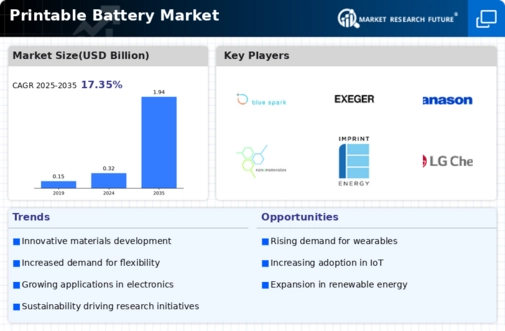Growth in Renewable Energy Solutions
The transition towards renewable energy sources is influencing the Printable Battery Market. As the world increasingly focuses on sustainability, there is a growing need for efficient energy storage solutions. Printable batteries, which can be produced using eco-friendly materials, align with this trend. The energy storage market is expected to grow at a compound annual growth rate of 20% over the next five years, suggesting a substantial opportunity for printable batteries in energy applications. This growth may lead to enhanced research and development efforts within the Printable Battery Market, fostering innovation and expanding its applications.
Rising Demand for Flexible Electronics
The increasing demand for flexible electronics is a primary driver for the Printable Battery Market. As consumer electronics evolve, manufacturers seek lightweight and adaptable power sources. Printable batteries, with their thin and flexible design, are well-suited for integration into wearable devices, smart textiles, and other innovative applications. According to recent estimates, the flexible electronics market is projected to reach USD 50 billion by 2026, which could significantly boost the demand for printable batteries. This trend indicates a shift towards more versatile power solutions, positioning the Printable Battery Market as a key player in the future of electronics.
Advancements in Manufacturing Techniques
Innovations in manufacturing techniques are propelling the Printable Battery Market forward. Techniques such as roll-to-roll printing and inkjet printing are enhancing the production efficiency and scalability of printable batteries. These advancements allow for lower production costs and faster manufacturing times, making it feasible to produce batteries at a larger scale. As the market for printed electronics continues to expand, the Printable Battery Market stands to benefit from these technological improvements. The ability to produce high-quality batteries quickly and cost-effectively could lead to increased adoption across various sectors, including consumer electronics and automotive.
Increased Investment in Research and Development
The surge in investment for research and development within the Printable Battery Market is noteworthy. Companies and research institutions are allocating significant resources to explore new materials and technologies that enhance battery performance. This focus on innovation is likely to yield breakthroughs in energy density, charging speed, and overall efficiency. As a result, the market could witness a wave of new products that meet the evolving needs of consumers and industries alike. The commitment to R&D may also attract partnerships and collaborations, further strengthening the Printable Battery Market.
Regulatory Support for Clean Energy Technologies
Regulatory frameworks supporting clean energy technologies are emerging as a crucial driver for the Printable Battery Market. Governments worldwide are implementing policies that encourage the adoption of sustainable energy solutions, including energy storage systems. These regulations often provide incentives for the development and deployment of innovative technologies, such as printable batteries. As these policies gain traction, the Printable Battery Market may experience accelerated growth, as manufacturers seek to comply with new standards and capitalize on available incentives. This supportive environment could foster a more robust market for printable batteries.


















Leave a Comment